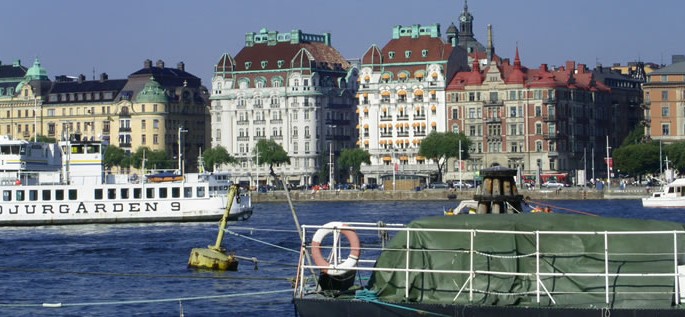Like other old IE languages
both PG and the OG languages had a synthetic grammatical structure,
which means that the relationships between the parts of the sentence
were shown by the forms of the words rather than by their position or
by auxiliary words. In later history all the Germanic languages
developed analytical forms and ways of word connection.
In the early periods of
history the grammatical forms were built in the synthetic way: by
means of inflections, sound interchanges and suppletion.
The
suppletive
/sə’pli:tiv/
way of form-building was inherited from ancient IE, it was restricted
to a few personal pronouns, adjectives and verbs.
Compare the following forms of
pronouns in Germanic and non-Germanic languages:
|
L |
Fr |
R |
Gt |
ОIcel |
OE |
NE |
|
ego mei mihi |
je mon me, |
я |
ik |
ek |
ic |
I |
|
меня |
meina |
min |
min |
my, mine |
||
|
мне |
mis |
mer |
me |
me |
The
principal means of form-building were inflections. The inflections
found in OG written records correspond to the inflections used in
non-Germanic languages, having descended from the same original IE
prototypes. Most of them, however, were simpler and shorter, as they
had been shortened and weakened in PG.
The wide use of sound
interchanges has always been a characteristic feature of the Germanic
group. This form-building (and word-building) device was inherited
from IE and became very productive in Germanic. In various forms of
the word and in words derived from one and the same root, the
root-morpheme appeared as a set of variants. The consonants were
relatively stable, the vowels were variable (Consonant interchanges
were also possible but rare. They appeared in PG due to voicing of
fricatives under Verner’s Law but were soon levelled out).
Table 6 shows the variability
of the root *ber- in different grammatical forms and words.
Table 6
Variants of the Root *bef-
|
Old Germanic languages |
Modern Germanic languages |
|||||
|
Gt |
О Icel |
OE |
Sw |
G |
NE |
|
|
forms of the verb bear |
bairan bar berum baurans |
bera bar barum borinn |
beran b r b ron boren birp |
bära bar buro buren |
gebären gebar — geboren |
bear
bore (pl) born bears |
|
other words from the same |
barn baur |
barn burðr byrð |
bearn ʒbyrd |
barn |
Geburt |
barn ‘child’) birth |
Соседние файлы в предмете [НЕСОРТИРОВАННОЕ]
- #
- #
- #
- #
- #
- #
- #
- #
- #
- #
- #
Germanic languages are spoken by close to 470 million people in many parts of the world, but mainly in Europe and the Western Hemisphere. All modern Germanic languages derive from a common ancestor traditionally referred to as *Proto-Germanic, believed to have broken off from other *Proto-Indo-European languages some time before 500 B.C. Although no written documents in Proto-Germanic have survived, the language has been substantially reconstructed by using the oldest existing records. Compared to *Proto-Indo-European, **Proto-Germanic had a relatively simpler nominal morphology. For instance, it dropped the dual number, and reduced the number of cases from eight to four. On the other hand, the verbal morphology of *Proto-Indo-European survived relatively intact in all modern Germanic languages, although there are fewer strong (irregular) verbs today.
Some 50 modern Germanic languages are spoken today (Ethnologue) .
They are usually divided into two groups.
| West Germanic | ||
|---|---|---|
| # of speakers | Spoken primarily in | |
| Afrikaans | 6.2 million 1st, 10 million 2nd language speakers | South Africa |
| Dutch (including Flemish) | 21 million | Netherlands, Belgium |
| Zeeuws | 220,000 | Netherlands |
| Low Saxon (10 varieties) | 995,000 | Netherlands, Germany, Canada |
| English | 341 million 1st, over 1 billion 2nd language speakers | British Commonwealth countries, U.S. |
| Frisian Western Frisian Eastern Frisian Northern |
700,000 11,000 10,000 |
Netherlands Germany Germany |
| German | 95 million 1st, 28 million 2nd language speakers | Germany |
| Lower Silesian | no estimate available | Poland |
| Upper Saxon | 2 million | Germany |
| Luxembourgeois | 390,000 | Luxembourg |
| Mainfränkisch | no estimate available | Germany |
| Pennsylvania | 85,000 | USA |
| Pfälzisch | no estimate available | Germany |
| Limburgisch | 1.5 million | Netherlands |
| Kölsch | 250,000 | Germany |
| Scots | 200,000 | United Kingdom |
| Yiddish | under 2 million | Israel, U.S. |
| North Germanic (Norse, Scandinavian) | ||
| # of speakers | Spoken primarily in | |
| Danish | 6 million | Denmark |
| Faroese | 45,000 | Faroe Islands (Denmark) |
| Icelandic | 230,000 | Iceland |
| Norwegian | 5 million | Norway |
| Swedish | 8.8 million | Sweden |
| East Germanic | ||
| # of speakers | Spoken primarily in | |
| Gothic | extinct | Ukraine, Bulgaria |
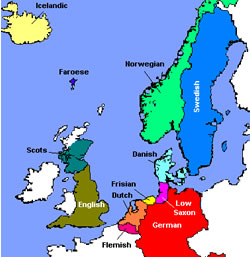
Click on the MLA Interactive Language Map to find out where Scandinavian languages are spoken in the U.S.
Status
The following Germanic languages have official status. An official language is one that is given a privileged legal status in a state, or other legally-defined political entity. Some countries have only one official language, e.g., Norway, while others may have several, e.g., the Netherlands. Some countries, e.g., US, do not have an official language.
|
Afrikaans |
South Africa (along with 11 other languages) |
|---|---|
|
Danish |
Denmark, Faroe Islands, Greenland |
|
Dutch |
Netherlands (with Frisian), Belgium (with French and German), Suriname, Netherland Antilles, Aruba |
|
English |
UK and British Commonwealth Countries, US and its territories, other countries on all continents (total 53 countries) |
|
Frisian |
Netherlands (with Dutch) |
|
German |
Austria, Belgium (with Dutch and French), Germany, Liechtenstein, Luxembourg (with French and Luxembourgish), South Tyrol (with Italian), Switzerland (with French, Italian, and Rhaeto-Romansch) |
|
Norwegian |
Norway |
|
Swedish |
Sweden, Finland (with Finnish) |
In addition, German is one of the 23 official languages of the European Union and one of the three working languages of the European Commission,along with English and French.
Dialects
Structure
Sound system
All Germanic languages have undergone some common sound changes:
- First Germanic Sound Shift (Grimm’s Law)
You probably know of Jacob Grimm as the author of fairy tales. But he was also one of the great linguists of the 19th century. He found evidence for the unity of all the modern Germanic languages in the phenomenon known as the First Germanic Sound Shift (also known as Grimm’s law ), which set the Germanic branch apart from the other branches of the Indo-European family. This shift occurred before the 7th century when records started to be kept. According to Grimm’s law, the shift occurred when /p, t, k/ in the classical Indo-European languages (Latin, Greek, and Sanskrit) became/ f, t, h/ in Germanic languages. For example, Latin pater > English father, Latin cornu > English horn. - Second Germanic consonant shift (High German consonant shift)
The Second consonant shift took place probably beginning between the 3rd-5th centuries AD, and was almost complete before the earliest written records in the High German language were made in the 9th century. It occurred in High German (spoken in mountainous areas) which gave rise to today’s Standard German. Low German dialects were not affected by the Second Consonant Shift. Here are some examples: classical Indo-European /k, t, p/ became /h, th, f/ in English and /h, d, f/ in German. For example, Latin frater > English brother and German Bruder.
classical Indo-European /g, d, b/ became /k, t, p/ in English and /kh, ts, f/ in German. For example, Latin decem > English ten and German zehn.
Click here to learn more about the Second Consonant Shift.
Vowels
Most modern Germanic languages have a large inventory of vowel phonemes consisting of 14-16 vowels. Vowel length typically distinguishes word meaning, and there is a contrast between rounded and unrounded front vowels in many of the Germanic languages.
Consonants
Modern Germanic languages have fairly similar consonant systems consisting of 20-22 phonemes.
Stress
All Germanic languages are characterized by a shift of stress to the root and later to the first syllable of the word. Though English has an irregular stress pattern, native words always have a fixed stress, regardless of what is added to them. In addition, some Germanic languages have a pitch accent, e.g.,Norwegian and Swedish).
Grammar
All Germanic languages are synthetic, i.e., they add suffixes to roots and stems to express grammatical relations. However, they differ from each other in how conservative or how progressive each language is with respect to preserving the inflectional system of *Proto-Germanic. For instance, German, Dutch and Icelandic, have preserved much of the complex inflectional morphology of inherited from *Proto-Germanic. Others, like English, Swedish, Yiddish, and Afrikaans have lost most of the inflections.
Nouns
Some of the general features of Germanic nouns are listed below.
- All Germanic languages have two numbers: singular and plural.
- The majority of Germanic languages have two genders: masculine and feminine. German, Dutch, and Icelandic have preserved the neuter gender.Dutch has two genders – common (masculine and feminine) and neuter.
- Case inflections have all but disappeared in most Germanic languages, with the exception of German, and Icelandic that have retained four cases: nominative, accusative, dative and genitive.
- All Germanic languages have strong (irregular) and weak (regular) nouns. Strong nouns have a change in the root vowel, e.g., English foot(singular) and feet (plural).
- All Germanic languages have a definite and indefinite article. The definite article may precede the noun or be suffixed to the noun, e.g., in Icelandic.
- Many Germanic languages form the possessive by the addition of –s or –es, for example, English man, man’s; German Mann, Mannes.
- In most Germanic languages, articles and adjectives agree with nouns in gender and case in the singular; there is no gender distinction in the plural.
- In some Germanic languages adjectives have strong and weak endings.
- Personal pronouns have retained some case distinctions even if these were lost in the nouns, e.g., English.
Verbs
Below are some general features of Germanic verbs.
- All Germanic languages have strong and weak verbs. Strong verbs form the past tense and past participle by changing the root vowel, for example, English ring, rang, rung; German ringen, rang, gerungen. Weak verbs add an ending -d/-ed/-t, for example, English talk, talked, talked;German fragen, fragte, gefragt.
- Verbs are conjugated based on person (lst, 2nd, 3rd) and number (singular and plural).
- Verbs have simple and numerous compound tenses formed with auxiliary verbs such as have in English and haben in German.
- There are three moods: indicative, subjunctive/conditional, and imperative.
- There are two voices: active and passive.
Word order
Word order is best described in terms of the position of the verb in Germanic clauses. It occupies final position in subordinate clauses, and first or second position in main clauses. The position of all other sentence constituents is relatively free. This feature is shared by all Germanic languages, except English, which has a Subject-Verb-Object word order.
Vocabulary
Most words in Germanic languages are derived from *Proto-Germanic. Germanic languages have also borrowed from neighboring languages, and especially from Latin and Greek, as well as from each other. Much of its scientific terminology has Greek and Latin roots. The latest source of loanwords is English. Words are frequently formed by compounding, suffixation and prefixation, e.g., German Weihnachtsmann (literally ”Holy Night Man,’ i.e., ‘Santa Claus’), English antiestablishmentarianism.
Below are some common expressions in various Germanic languages, showing the similarities and differences among them.
| English | hello | good bye | please | thank you | yes/no |
| Afrikaans | hallo | totsiens | asseblief | dankie | ja/nee |
| Dutch | hallo | tot ziens | alstublieft | dankjewe | ja/nee |
| Danish | hej | farvel | behage | tak | ja/nej |
| German | hallo | auf Wiedersehen | bitte | danke | ja/nein |
| Icelandic | góðan dag | bless | gjörðu svo vel | takk fyrir | /nei |
| Norwegian | hallo | farvel | vær så snill | takk | ja/nei |
| Swedish | hej | hej då | behaga | tack | ja/nej |
| Yiddish | gut-morgn | a gutn tog | zay azoy gut | A dank | ye/neyn |
Below are the numerals 1-10 in major Germanic languages.
| 1 | 2 | 3 | 4 | 5 | 6 | 7 | 8 | 9 | 10 | |
|---|---|---|---|---|---|---|---|---|---|---|
| English | one | two | three | four | five | six | seven | eight | nine | ten |
| Afrikaans | een | twee | drie | vier | vyf | ses | sewe | agt | nege | tien |
| Dutch | een | twee | drie | vier | vijf | zes | zeven | acht | negen | tien |
| Danish | en | to | tre | fire | fem | seks | syv | otte | ni | ti |
| German | eins | zwei | drei | vier | fünf | sechs | sieben | acht | neun | zehn |
| Icelandic | einn | tveir | þrir | fjórir | fimm | sex | sjo | ötta | níu | tíu |
| Norwegian | en, ein | to | tre | fire | fem | seks | sy | åtte | ni | ti |
| Swedish | ett | två | tre | fyra | fem | sex | sju | åtta | nio | tio |
| Yiddish | eyns | tswei | dray | fier | finfef | zeks | zibn | ahet | nayn | tsen |
Writing
The earliest evidence of Germanic writing comes from names recorded in the 1st century by Tacitus. From roughly the 2nd century AD, certain speakers of early Germanic dialects developed the Elder Futhark, an early form of the runic alphabet, some examples of which go back to the 3rd century AD. It is thought that the runes were based on an Etruscan-related alphabet, adapted to represent the sounds of Germanic languages and styled to allow carving on wood, stone, and metal. Each rune not only represents a sound but also has a special meaning frequently connected with Norse mythology. For instance, the image on the left, called Ansuz, was most often associated with Odin, the chief god of Norse mythology, the Viking equivalent of Zeus, the god of sky and thunder in Greek mythology.
Early runic inscriptions were largely limited to personal names, and difficult to interpret. Later, Christian priests and monks who spoke and read Latin in addition to their native Germanic dialects began writing the Germanic languages with slightly modified Latin letters. However, throughout the Viking Age, runic alphabets remained in common use in Scandinavia.
Click here to see your name written in runes and to learn more about this ancient writing system.
Today, Germanic languages use the standard 26-letter Latin alphabet expanded to include extra letters to represent vowel sounds.
Below is Article 1 of the Universal Declaration of Human Rights in several major Germanic languages.
| English Universal Declaration of Human Rights Article 1 All human beings are born free and equal in dignity and rights. They are endowed with reason and conscience and should act towards one another in a spirit of brotherhood. |
| Afrikaans Universele Verklaring van Menseregte Artikel 1 Alle menslike wesens word vry, met gelyke waardigheid en regte, gebore. Hulle het rede en gewete en behoort in die gees van broederskap teenoor mekaar op te tree. |
| Dutch Universele verklaring van de rechten van de mens Artikel 1 Alle mensen worden vrij en gelijk in waardigheid en rechten geboren. Zij zijn begiftigd met verstand en geweten, en behoren zich jegens elkander in een geest van broederschap te gedragen. |
| Icelandic Mannréttindayfirslýsing Sameinuðo Þjóðanna 1. grein. Hver maður er borrinn frjáls og jafn öðrum að virðing og réttindum. Menn eru gæddir vitsmunum og samvizku, og ber þeim að breyta bróðurlega hverjum við annan. |
| Danish Verdebserklaeringen om Menneskrrettighederne Artikel 1. Alle mennesker er tødt frie og lige i værdghed og rettigheder. De er udstyret men tornuft og samyttighed, og de bør handle mod hverandre i en broderskabets ånd. |
| German Die Allgemeine Erklärung der Menschenrechte Artikel 1 Alle Menschen sind frei und gleich an Würde und Rechten geboren. Sie sind mit Vernunft und Gewissen begabt und sollen einander im Geist der Brüderlichkeit begegnen. |
| Norwegian Bokmål Verdemserkæringen om mennesker ettighetene Artikkel 1. Alle mennesker er fød frie og med samme menneskeverd og menneskerettigheter. De er utstyrt med fornuft og samvittighet og bør handle mot hverandre i brorskapets ånd. |
| Norwegian Nynorsk Den internasjonale frasegna om mennesker ettane Artikkel 1. Alle menneske er fødde til fridom og med same menneskeverd og menneskerettar. Dei har fåt fornuft og samvit og skal leve med kvarandre som brør. |
| Swedish Allmän Förklaring om de Mänskliga Rättigheterna Artikel 1. Alla människor är födda fria och lika i värde och rättigheter. De är utrustade med förnuft och samvete och bör handla gentemot varandra i en anda av broderskap. |
Difficulty
Language Difficulty

Afrikaans, Danish, Dutch,Norwegian and Swedish are considered to be Category I languages in terms of difficulty for English speakers (24 weeks of full-time instruction to reach ILR S-3). German is somewhat more difficult (30 weeks). Icelandic is considered to be Category III language (44 weeks).
Слайд 1
Lecture 5. Linguistic Features of Germanic Languages.Grammar.
1. Germanic
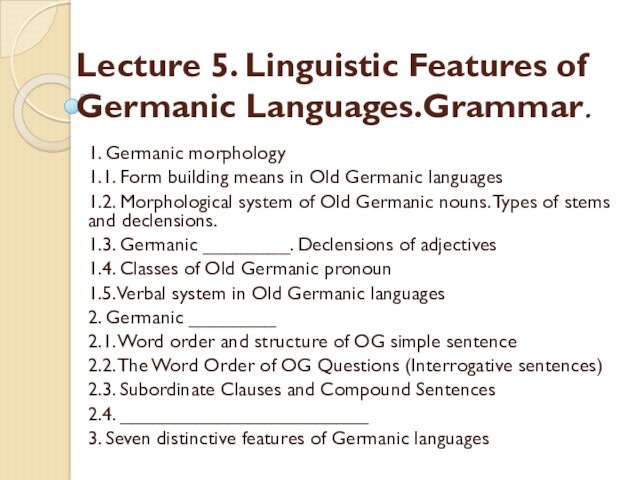
morphology
1.1. Form building means in Old Germanic languages
1.2. Morphological
system of Old Germanic nouns. Types of stems and declensions.
1.3.
Germanic ________. Declensions of adjectives
1.4. Classes of Old Germanic pronoun
1.5. Verbal system in Old Germanic languages
2. Germanic ________
2.1. Word order and structure of OG simple sentence
2.2. The Word Order of OG Questions (Interrogative sentences)
2.3. Subordinate Clauses and Compound Sentences
2.4. _______________________
3. Seven distinctive features of Germanic languages
Слайд 2
What is grammar?
__________________________________________________________________________________________________
__________________________________________________________________
= morphology, _______, and phonology,
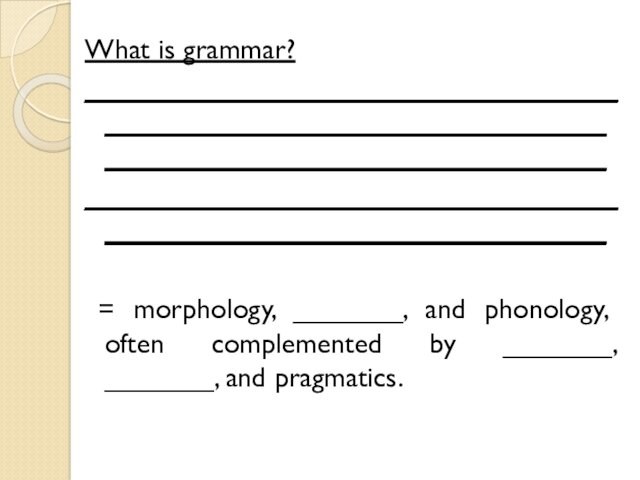
often complemented by _______, _______, and pragmatics.
Слайд 3
Grammar is a branch of Linguistics, including _______and
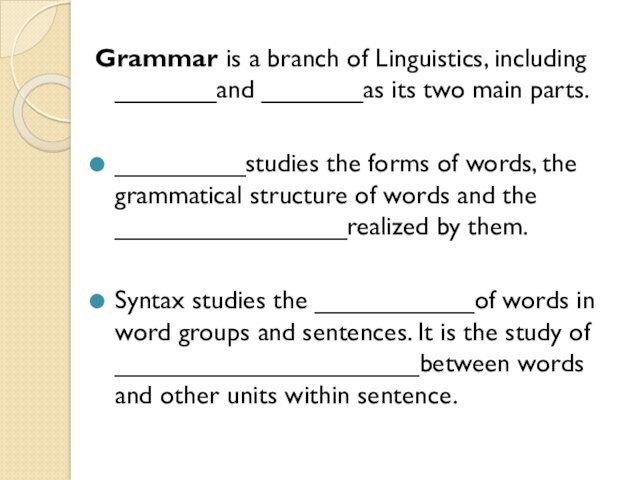
_______as its two main parts.
_________studies the forms of words,
the grammatical structure of words and the ________________realized by them.
Syntax
studies the ___________of words in word groups and sentences. It is the study of _____________________between words and other units within sentence.
Слайд 4
A synthetic language is a language which uses
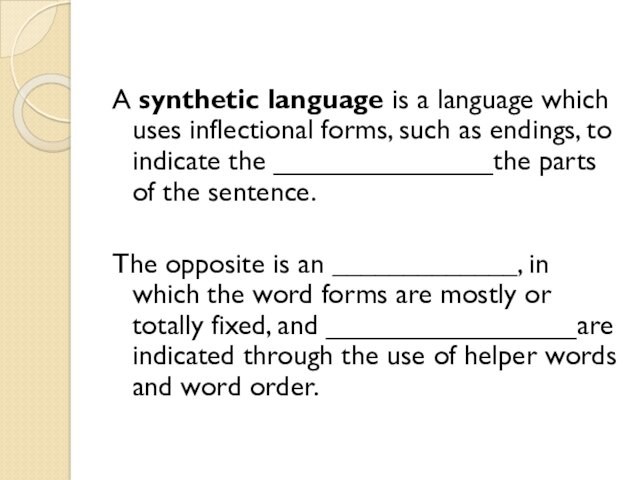
inflectional forms, such as endings, to indicate the ______________the
parts of the sentence.
The opposite is an _____________, in
which the word forms are mostly or totally fixed, and ________________are indicated through the use of helper words and word order.
Слайд 5
1. Germanic __________
1.1. Form Building Means
The formation of
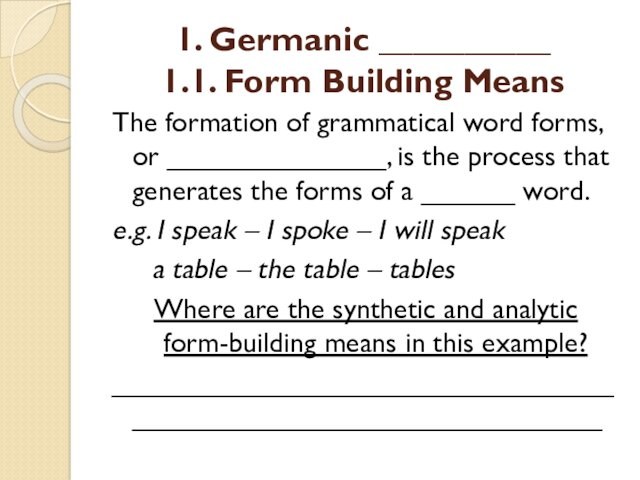
grammatical word forms, or ______________, is the process that
generates the forms of a ______ word.
e.g. I speak –
I spoke – I will speak
a table – the table – tables
Where are the synthetic and analytic form-building means in this example?
______________________________________________________________
Слайд 6
PIE = EPG = LPG = _________languages
Synthetic
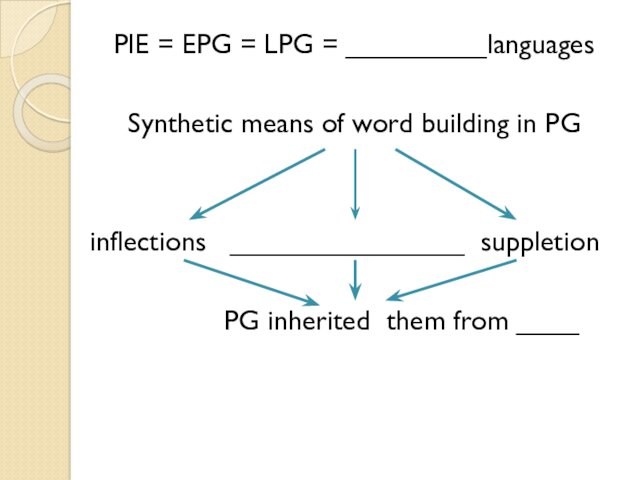
means of word building in PG
inflections _______________
suppletion
PG
inherited them from ____
Слайд 7
__________ (endings) = the principal means of form-building
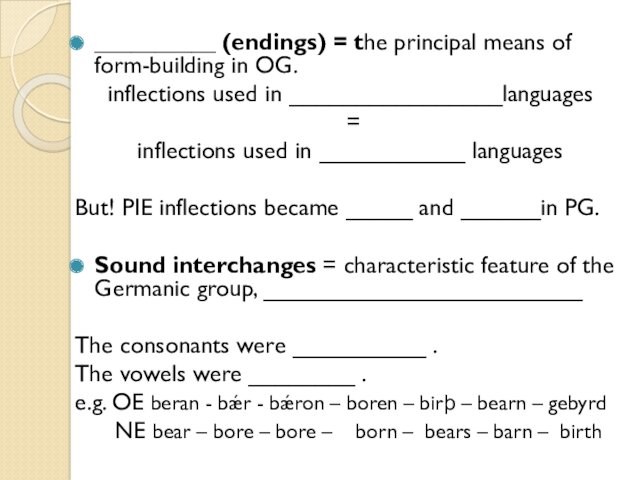
in OG.
inflections used in ________________languages
=
inflections used
in ___________ languages
But! PIE inflections became _____ and ______in PG.
Sound
interchanges = characteristic feature of the Germanic group, ________________________
The consonants were __________ .
The vowels were ________ .
e.g. OE beran — bǽr — bǽron – boren – birϸ – bearn – gebyrd
NE bear – bore – bore – born – bears – barn – birth
Слайд 8
What linguistic term is used for these sound
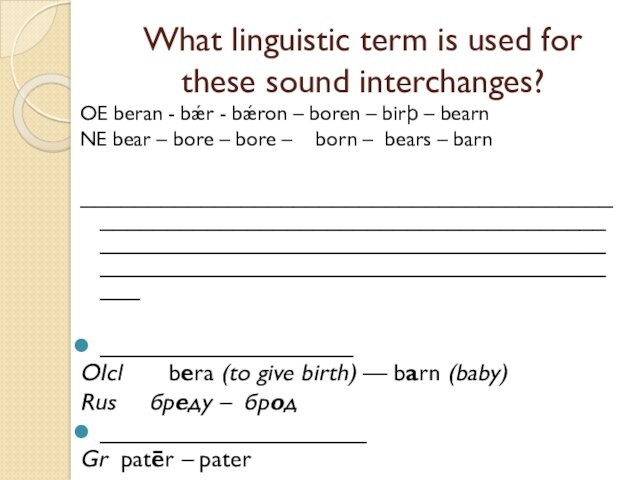
interchanges?
OE beran — bǽr — bǽron – boren –
birϸ – bearn
NE bear – bore – bore –
born – bears – barn
_____________________________________________________________________________________________________________________________________________________________
___________________
OIcl bera (to give birth) — barn (baby)
Rus бреду – брод
____________________
Gr patēr – pater
Слайд 9
Suppletion
The suppletive way of form-building
=
__________________________________________________________________________
=
a few
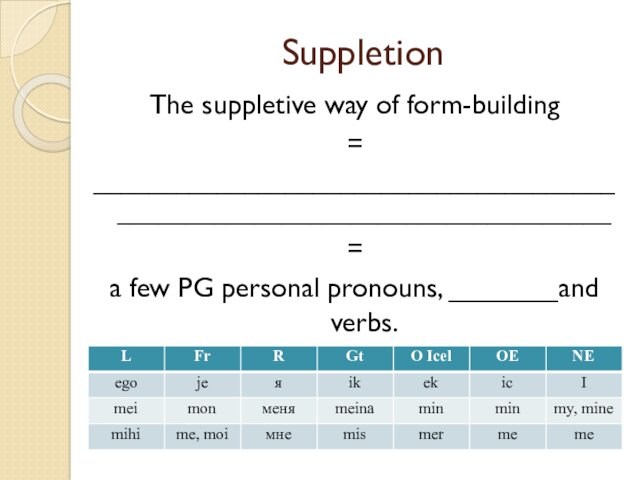
PG personal pronouns, _______and verbs.
Compare the following forms of
pronouns in Germanic and non- Germanic languages:
Слайд 10
1. 2. Morphological System of Old Germanic Nouns
The
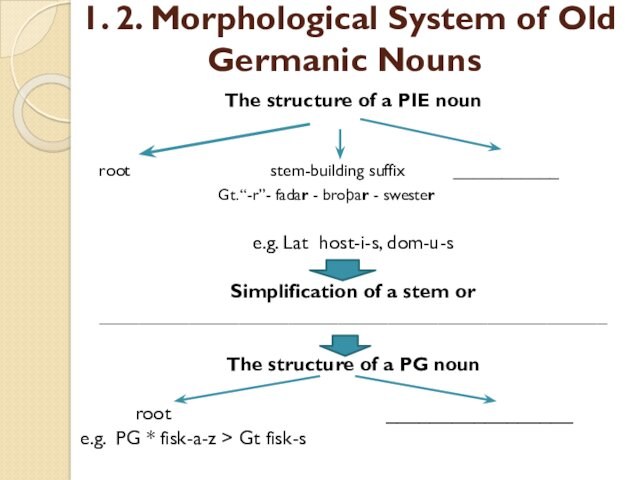
structure of a PIE noun
root
stem-building suffix ___________
Gt. “-r”- fadar — broϸar — swester
e.g. Lat host-i-s, dom-u-s
Simplification of a stem or
___________________________________________________
The structure of a PG noun
root _________________
e.g. PG * fisk-a-z > Gt fisk-s
Слайд 11
Types of Noun Stems and declensions in OG
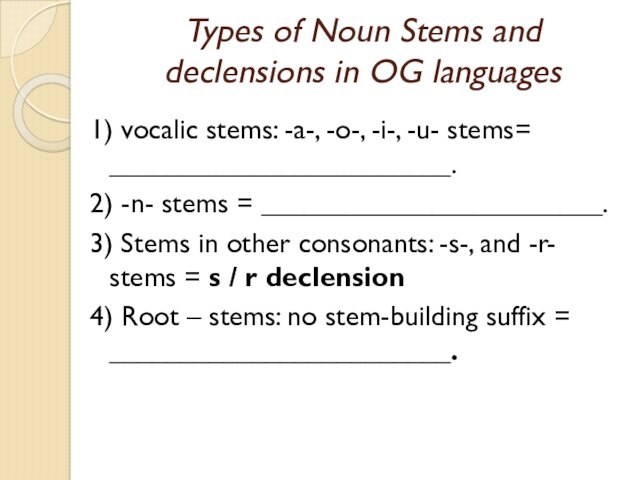
languages
1) vocalic stems: -a-, -o-, -i-, -u- stems= ________________________.
2) -n- stems = ________________________.
3) Stems in other consonants:
-s-, and -r- stems = s / r declension
4) Root – stems: no stem-building suffix = ________________________.
Слайд 12
What is a declension?
__________________________________________________________________________________________________________________
e.g. Eng a man –
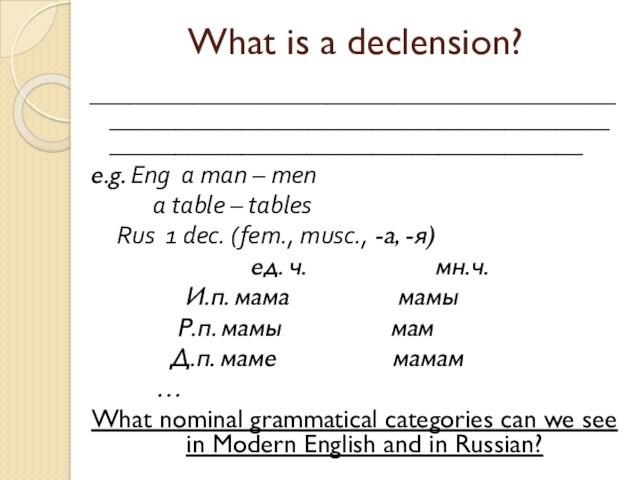
men
a table –
tables
Rus 1 dec. (fem., musc., -а, -я)
ед. ч. мн.ч.
И.п. мама мамы
Р.п. мамы мам
Д.п. маме мамам
…
What nominal grammatical categories can we see in Modern English and in Russian?
Слайд 14
1.3. The Old Germanic Adjective
Adjectives = _______in PIE
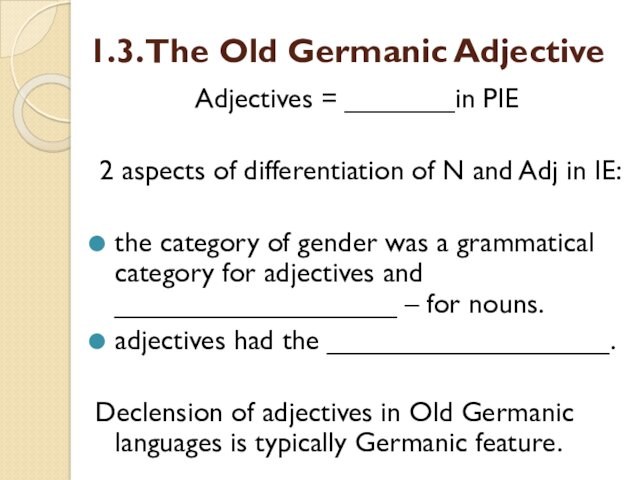
2 aspects of differentiation of N and Adj in
IE:
the category of gender was a grammatical category for adjectives
and __________________ – for nouns.
adjectives had the __________________.
Declension of adjectives in Old Germanic languages is typically Germanic feature.
Слайд 15
Every adjective in OG was declined according to
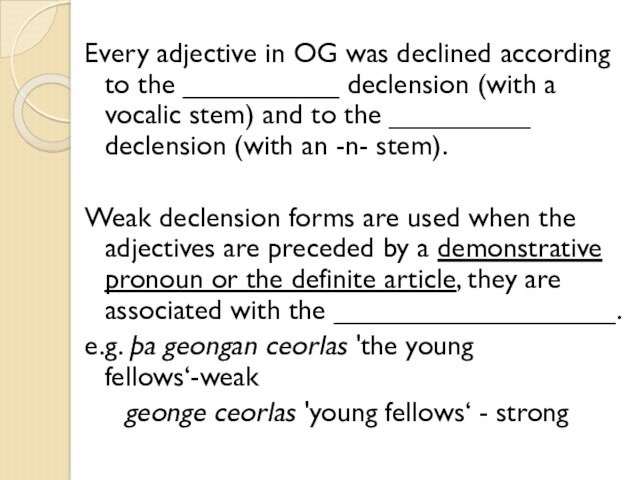
the __________ declension (with a vocalic stem) and to
the _________ declension (with an -n- stem).
Weak declension forms
are used when the adjectives are preceded by a demonstrative pronoun or the definite article, they are associated with the __________________.
e.g. þa geongan ceorlas ‘the young fellows‘-weak
geonge ceorlas ‘young fellows‘ — strong
Слайд 16
Degrees of comparison
_____ degrees of comparison in OG:
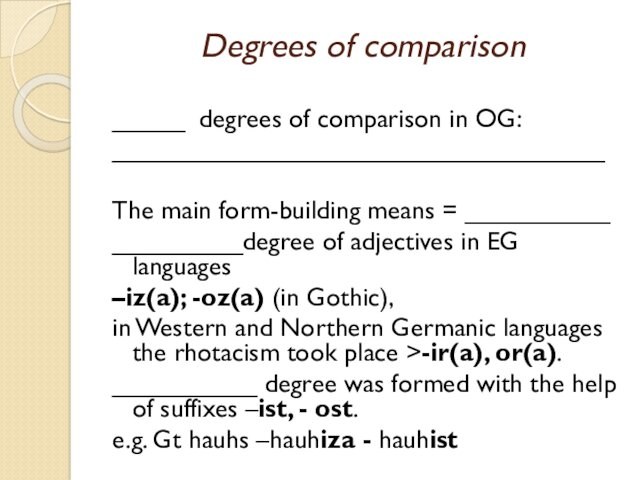
__________________________________
The main form-building means = __________
_________degree of adjectives in
EG languages
–iz(a); -oz(a) (in Gothic),
in Western and Northern
Germanic languages the rhotacism took place >-ir(a), or(a).
__________ degree was formed with the help of suffixes –ist, — ost.
e.g. Gt hauhs –hauhiza — hauhist
Слайд 17
1. 4. Classes of pronouns in OG
Modern
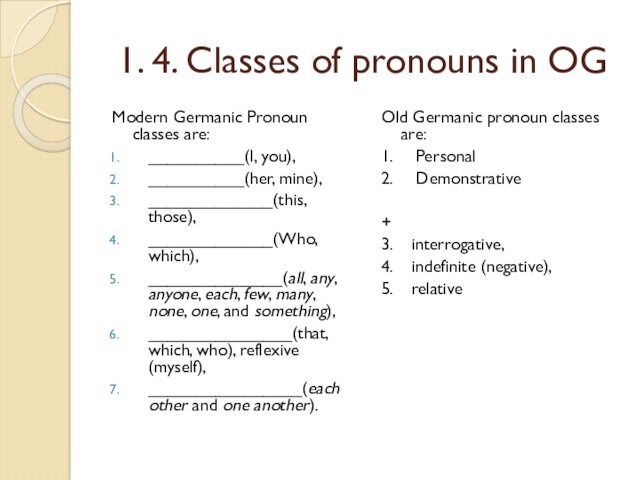
Germanic Pronoun classes are:
__________(I, you),
__________(her, mine),
_____________(this,
those),
_____________(Who, which),
______________(all, any, anyone, each, few, many, none,
one, and something),
_______________(that, which, who), reflexive (myself),
________________(each other and one another).
Old Germanic pronoun classes are:
1. Personal
2. Demonstrative
+
3. interrogative,
4. indefinite (negative),
5. relative
Слайд 18
In OG (OE, Gothic), there are besides singular
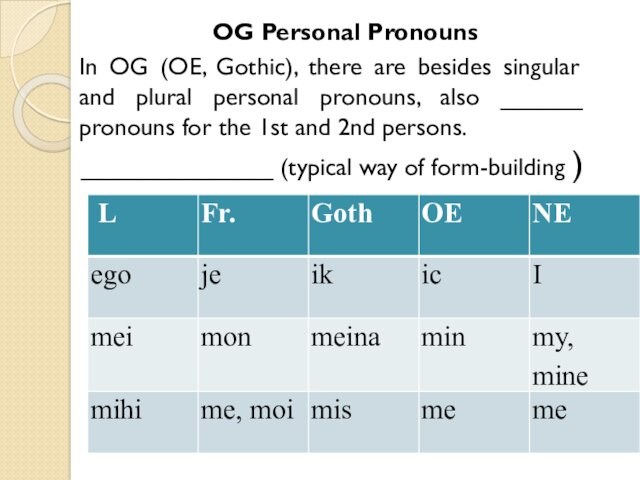
and plural personal pronouns, also ______ pronouns for the
1st and 2nd persons.
______________ (typical way of form-building )
OG
Personal Pronouns
Слайд 19
1. 5. Verbal system in Old Germanic languages
____________
PIE
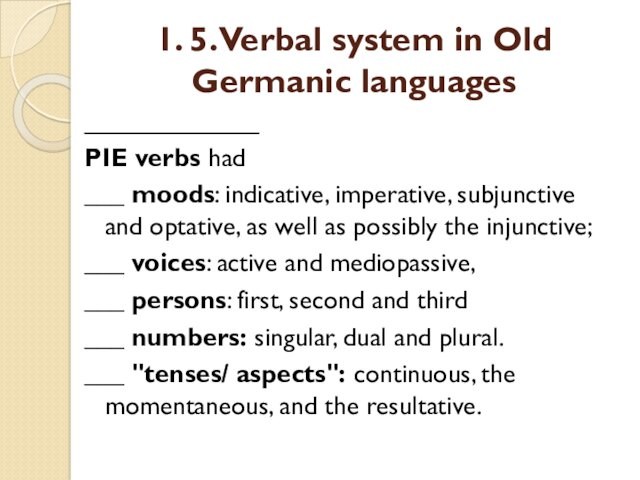
verbs had
___ moods: indicative, imperative, subjunctive and optative,
as well as possibly the injunctive;
___ voices: active and
mediopassive,
___ persons: first, second and third
___ numbers: singular, dual and plural.
___ «tenses/ aspects»: continuous, the momentaneous, and the resultative.
Слайд 20
OG verbs
Strong verbs
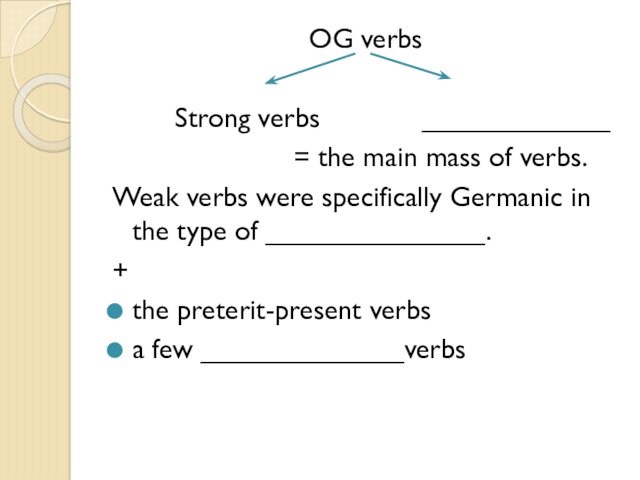
____________
=
the main mass of verbs.
Weak verbs were specifically Germanic in the type of ______________.
+
the preterit-present verbs
a few _____________verbs
Слайд 22
PIE Aspects >>>>>> Germanic tenses
Greek:
Leipo (I leave)
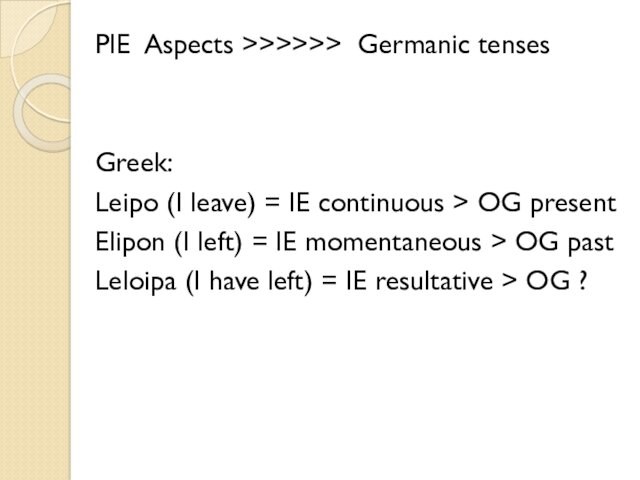
= IE continuous > OG present
Elipon (I left)
= IE momentaneous > OG past
Leloipa (I have left) =
IE resultative > OG ?
Слайд 23
Characteristic features of OG groups of verbs (______________)
Strong
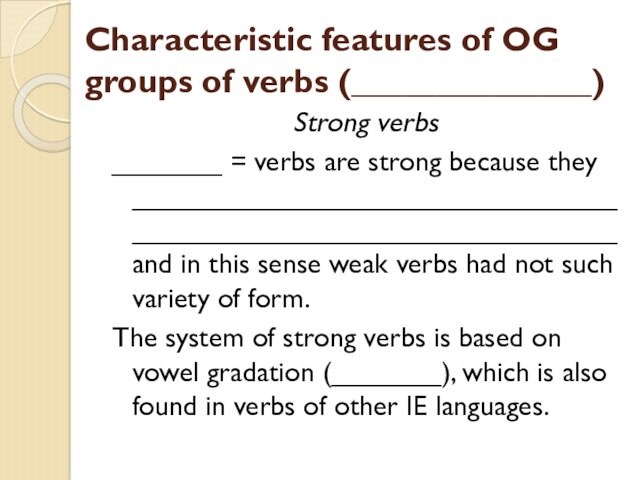
verbs
_______ = verbs are strong because they ______________________________________________________________ and
in this sense weak verbs had not such variety of
form.
The system of strong verbs is based on vowel gradation (_______), which is also found in verbs of other IE languages.
Слайд 24
Forms of the strong verbs
___ basic forms: the
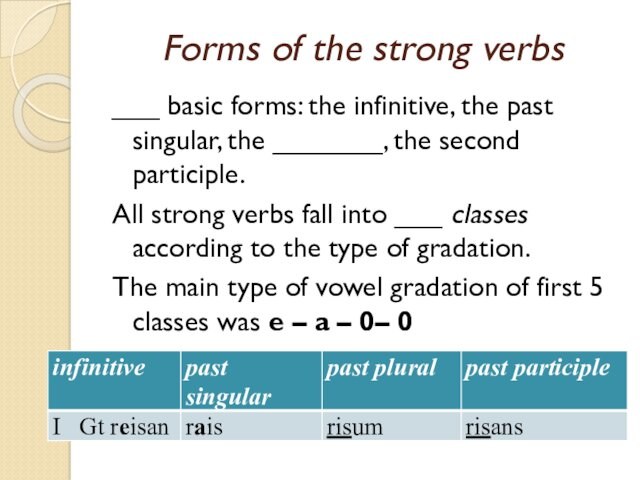
infinitive, the past singular, the _______, the second participle.
All
strong verbs fall into ___ classes according to the type
of gradation.
The main type of vowel gradation of first 5 classes was e – a – 0– 0
Слайд 25
Class ___ gradation is a-ȱ- ȱ -a
Verbs of
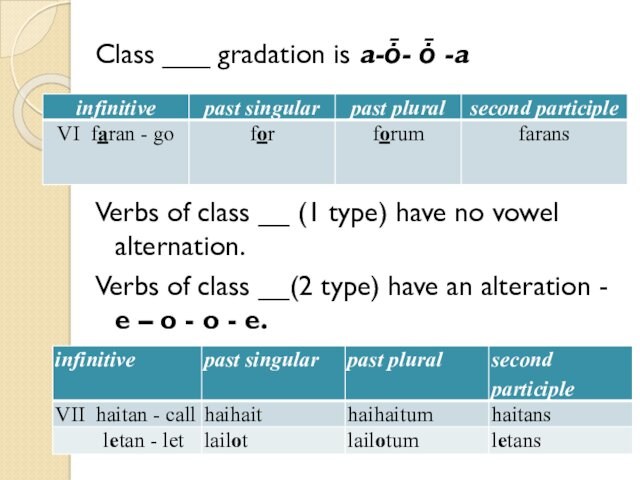
class __ (1 type) have no vowel alternation.
Verbs of
class __(2 type) have an alteration — e – o
— o — e.
Слайд 26
Weak verbs
Weak verbs derive their past tense and
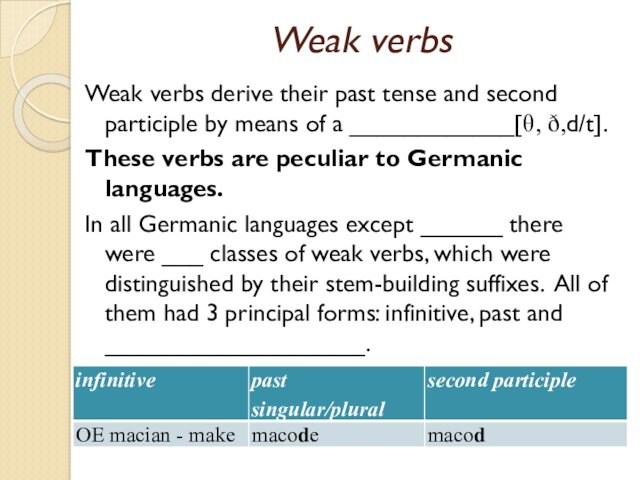
second participle by means of a ____________[θ, ð,d/t].
These
verbs are peculiar to Germanic languages.
In all Germanic languages
except ______ there were ___ classes of weak verbs, which were distinguished by their stem-building suffixes. All of them had 3 principal forms: infinitive, past and ___________________.
e
Слайд 27
The Gothic classes of weak verbs had the
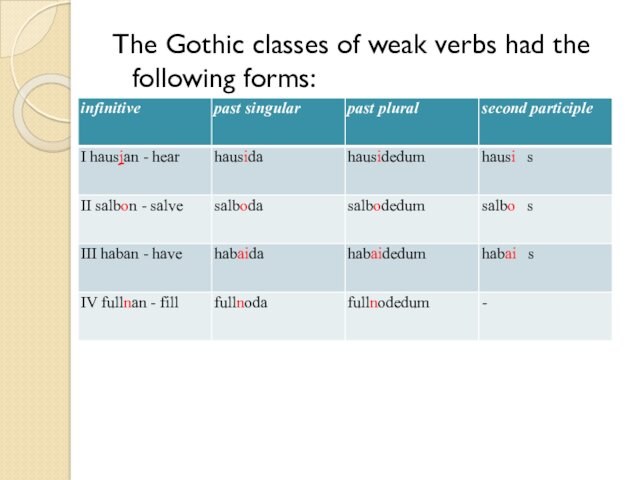
following forms:
Слайд 28
2. Germanic syntax
2.1. _____________and structure of OG simple
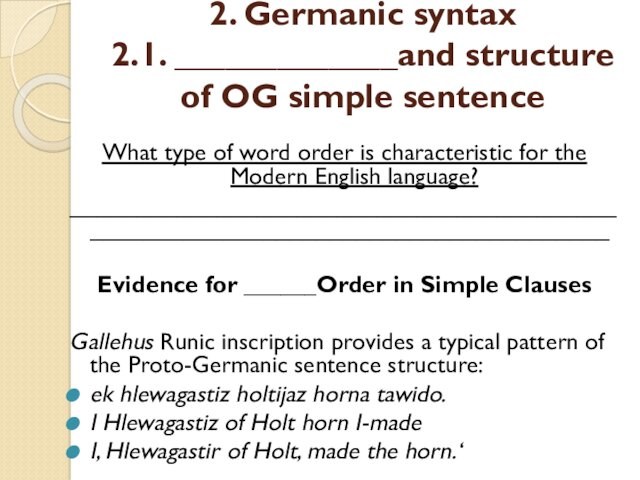
sentence
What type of word order is characteristic for the
Modern English language?
________________________________________________________________________________
Evidence for ______Order in Simple Clauses
Gallehus Runic inscription
provides a typical pattern of the Proto-Germanic sentence structure:
ek hlewagastiz holtijaz horna tawido.
I Hlewagastiz of Holt horn I-made
I, Hlewagastir of Holt, made the horn.‘
Слайд 29
Structural features typical for Old Germanic languages.
_____________________
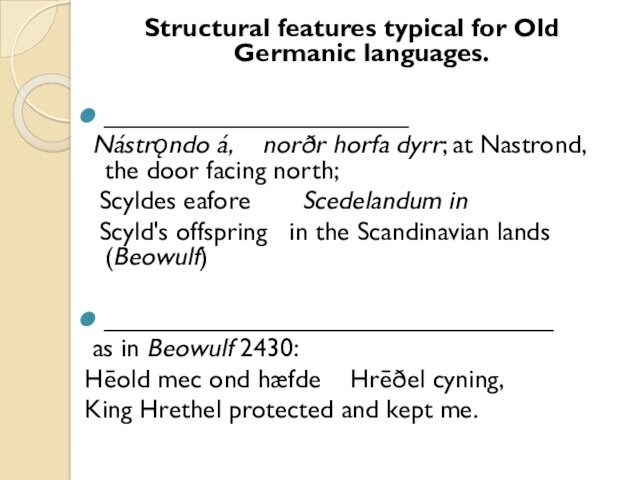
Nástrǫndo á, norðr horfa dyrr; at Nastrond, the door facing
north;
Scyldes eafore Scedelandum in
Scyld’s offspring in the Scandinavian
lands (Beowulf)
_______________________________
as in Beowulf 2430:
Hēold mec ond hæfde Hrēðel cyning,
King Hrethel protected and kept me.
Слайд 30
2.2. The Word Order of OG Questions (_____________________)
There
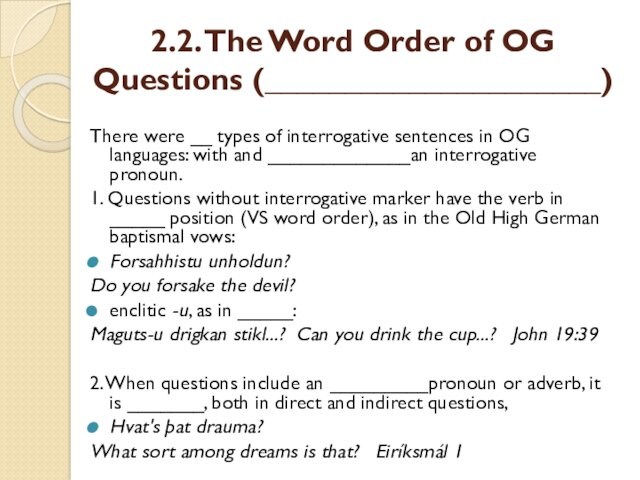
were __ types of interrogative sentences in OG languages:
with and _____________an interrogative pronoun.
1. Questions without interrogative marker have
the verb in _____ position (VS word order), as in the Old High German baptismal vows:
Forsahhistu unholdun?
Do you forsake the devil?
enclitic -u, as in _____:
Maguts-u drigkan stikl…? Can you drink the cup…? John 19:39
2. When questions include an _________pronoun or adverb, it is _______, both in direct and indirect questions,
Hvat’s þat drauma?
What sort among dreams is that? Eiríksmál 1
Слайд 31
2.3. Subordinate Clauses and Compound Sentences
Subordinate clauses may
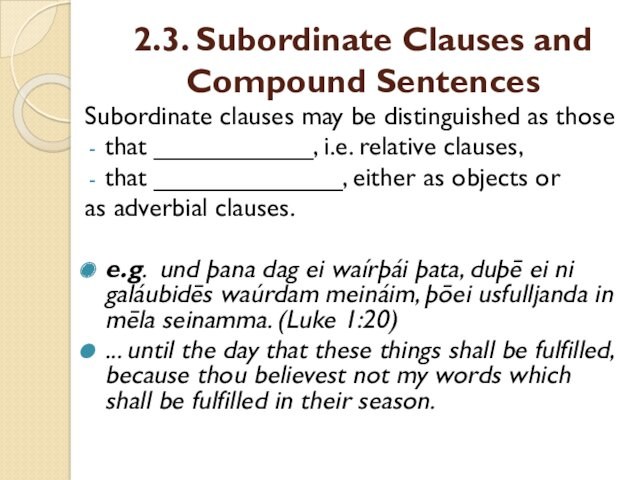
be distinguished as those
that ___________, i.e. relative clauses,
that _____________, either as objects or
as adverbial clauses.
e.g.
und þana dag ei waírþái þata, duþē ei ni galáubidēs waúrdam meináim, þōei usfulljanda in mēla seinamma. (Luke 1:20)
… until the day that these things shall be fulfilled, because thou believest not my words which shall be fulfilled in their season.
Слайд 32
2.4. Expression of Negation
Negation in OG languages =
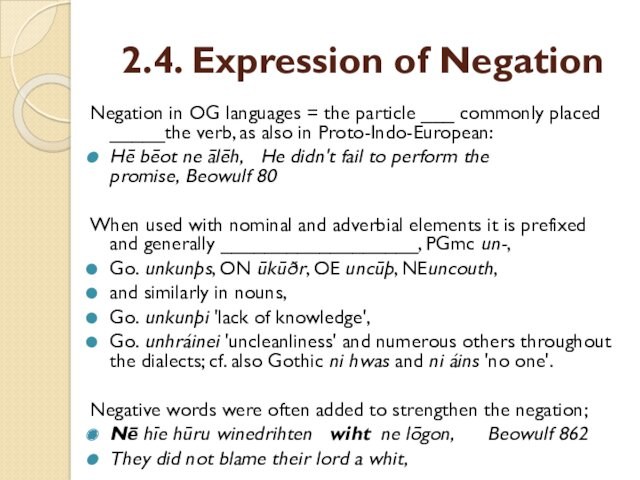
the particle ___ commonly placed _____the verb, as also in
Proto-Indo-European:
Hē bēot ne ālēh, He didn’t fail to perform the
promise, Beowulf 80
When used with nominal and adverbial elements it is prefixed and generally __________________, PGmc un-,
Go. unkunþs, ON ūkūðr, OE uncūþ, NEuncouth,
and similarly in nouns,
Go. unkunþi ‘lack of knowledge’,
Go. unhráinei ‘uncleanliness’ and numerous others throughout the dialects; cf. also Gothic ni hwas and ni áins ‘no one’.
Negative words were often added to strengthen the negation;
Nē hīe hūru winedrihten wiht ne lōgon, Beowulf 862
They did not blame their lord a whit,
Слайд 33
Seven distinctive features of Germanic languages
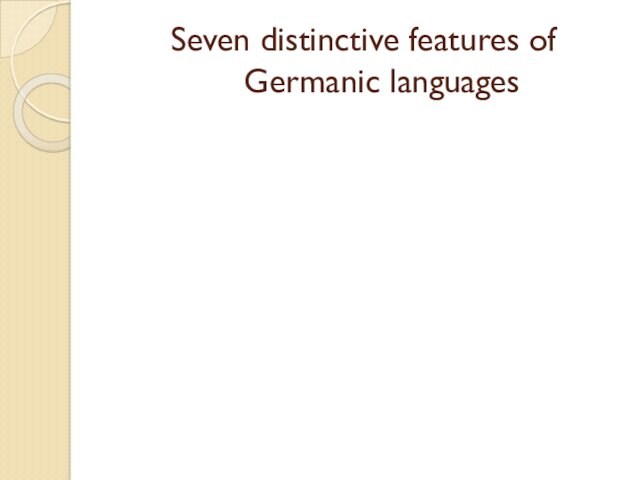
1. Linguistic features of Germanic languages
2. CONTENTS
Phonetics –
1) word stress
2) vowels
3) consonants
Morphology – 1) changing of grammatical forms
2) parts of speech
Vocabulary
3. WORD STRESS
Early Proto-Germanic – free and movable
Late Proto-Germanic – fixed on the first syllable –
root or prefix.
In simple forms the root-syllable was normally
stressed.
In compound forms (especially in nouns and
adjectives) the stress fell on the prefix.
In verbs the prefix was still a separate particle at
that time and did not take the stress.
PG fiskaz, Gt fisks, O Icel fiskr, OE fisk
4. VOWELS
IE short /ŏ/ and /ǎ/ correspond to GLs short /ǎ/: Gr
octō – Goth ahtau, Rus ночь – Germ nacht
IE long /ō/ and long /ā/ correspond to GLs long /ō/:
Lat frāter – Goth brōþar (брат), Lat flōs – OE blōma
(цветок).
In the root syllable IE /e/ = GL /i/, if it was followed by
1) /i/ 2) /j/ 3) nasal+consonant, else IE /e/ = G /e/.
Examples: Lat medius – OE middle (середина), Lat
ventus – OE wind (ветер) but Lat edere – OE etan
(есть).
IE /u/ = GL /u/ if followed by 1) /u/ 2)
nasal+consonant, else IE /u/ = G /o/.
Example: Lat sunus – OE sunu (сын)
5. CONSONANTS
The 1st Consonant Shift, or Grimm’s Law
IE G Examples
/ p / / f / Lat plěnus – Eng full
/ t / / þ / Gr tres – Eng three
/ k / / h / Lat noctem – Goth nahts
/ b / / p / Rus болото – Eng pool
/ d / / t / Lat duo – Goth twan
/ g / / k / Lat ego – OE ic
/ bh / / b / Sans bhratar – Eng brother
/ dh / / d / Sans madhu – OE medu
/ gh / / g / Lat hostis — Rus гость – Germ gast
6. CONSONANTS
Verner’s Law: unstressed vowel + voiceless stop
voiceless fricative
voiced fricative
voiced
stop: /t/ /þ/ /ð / /d/ Gr patěr=> OE fæder.
The consonant pairs involved in grammatical
alternation were f/b, þ/d, h/g, hw/w, s/r.
Some words retained traces of Verner’s Law:
death – dead
was – were
7. Morphology
Inflections were the principal means of form-
building .
Verb Forms Gt.
OE
Mod. E
Past. sing.
bar
bær
bore
Infinitive
bairan
beran
bear
Past. pl
berum
bæron
Part. II
baúrans
boren
born
Sound interchanges became very productive.
The principal gradation in IE languages was e – o
which is qualitative. (умереть – мор, беру — брал).
Suppletion- the forms of one and the same word
are built from different roots or stems: иду –шел,
хороший – лучше, я – меня; I-my,mine- me; ego-mei
8. NOUN
Classes of nouns: 1. vocalic stems a, o, i, u formed
strong declension;
2. n-stem formed the paradigm of weak declension;
3. s/r–stems;
4. root-stem nouns which had never had any stem
suffix, the root and the stem in these words always
coinsice.
Categories: 1. declension;
2. gender (masculine, feminine, neuter);
3. case (Nominative, Genitive, Dative, Accusative).
4. number (singular and plural).
9. ADJECTIVE
Adjective declension in all GLs has no parallel
with other IE languages.
1. strong declension which is a combination of
substantival and pronominal endings;
2. weak declenstion which reflected the declension
of n-stem substantives.
Categories: 1. gender;
2. number;
3. case;
4. degrees of comparison (positive, comparative,
superlative). Comparative degree was built by means of
the suffixes –iza, -oza; superlative degree was built with
the suffixes –ist, -ost.
10. PRONOUNS
The oldest classes are personal, demonstrative
and interrogative.
Personal pronoun had only two persons, the 3rd
person developed later from the demonstrative
pronouns.
Another ancient feature was the dual number of
personal pronouns (ic – wit – wē; þu – ʒit – ʒē ).
11. VERBS
1. Strong verbs (had four principal forms — Infinitive,
Past singular, Past plural and Participle II);
faran — fōr — fōrum – farans ( ехать )
letan – lailot – lailotum – letans ( оставлять )
2. weak verbs (Past tense, Participle I);
class infinitive
past sing. past plural
Participle II translation
I
hausjan
hausida
hausidēdum
hausiþs
слышать
II
salbōn
salbōda
salbōdēdum
salbōþs
мазать
III
haban
habaida
habaidēdum habaiþs
иметь
IV
fullnan
fulnōda
fullnōdēdum —
наполнять
12. VERBS
3. united preterit-present verbs (used vowel
gradation to derive the forms of the present tense
while their form of the preterit was build with the
help of the dental suffix..
Examples: OE wītan (inf) — wāt (pres sg) – wĭton (pres
pl) – wiste (pret sg) – wiston (pret pl) — ʓewiten (P2)
(знать).
Here belong modal verbs , verbs denoting possession
and verbs denoting estimation.
Categories: 1. number;
2. tense (Present and Past);
3. mood (indicative, imperative and subjunctive);
13. VOCABULARY
IE words
Mod. OE
O Sc Lat
E
man mann maðr mās
father fæder faðir pater
mothe mōdor moðir mater
r
heart heorte
cor
nose nosu
nasus
Greek Russia Sans
n
manu
patér
pitá(r)
mētér мать mātá(r)
kardia сердце
нос
nāsa
Pure Germanic words
Mod.
English
head
hand
bear
fir
sea
land
OE
German Swedish Gothic
hēāfod
hand
bera
furh
sæ:
land
Haupt
Hand
Bär
Föhre
See
Land
huvud
hand
björn
furu
sjö
land
haubiþ
handus
saiws
land
14. VOCABULARY
Borrowed words
Mod.
English
pound
street
plum,
wine
shield
write
canon
Other Germanic
languages
pund
Gt. pund, O. Ic. pund
stræt, strēt OHG atrâza OSc strâta
plūme
O Icl plóma
win
OHG, O Sc win G wein
scyld
O Sc skjoldr
scrifan
O Sc scrifa
canonic
O Sc kanunkr
OE
Latin
pondō
strata
prunus
vinum
scutum
scribere
canonicus

